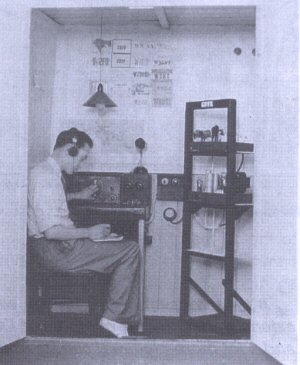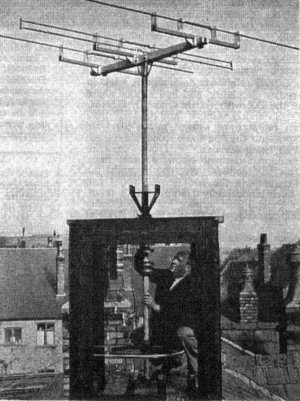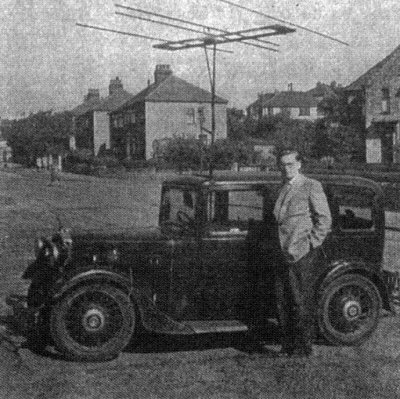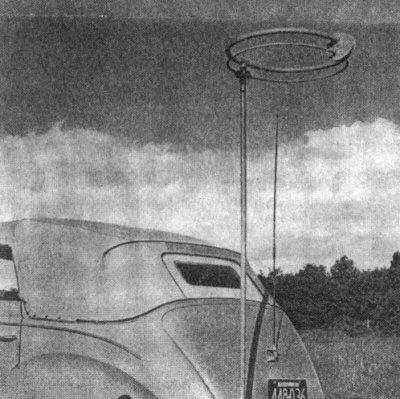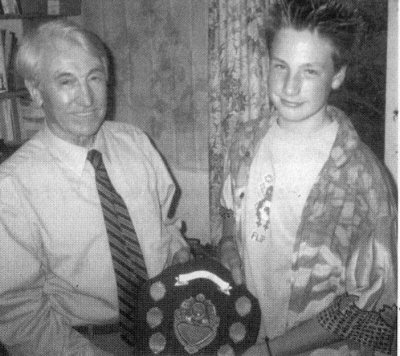

home > archive > the history of 6m > 50 years of 50 MHz part 6
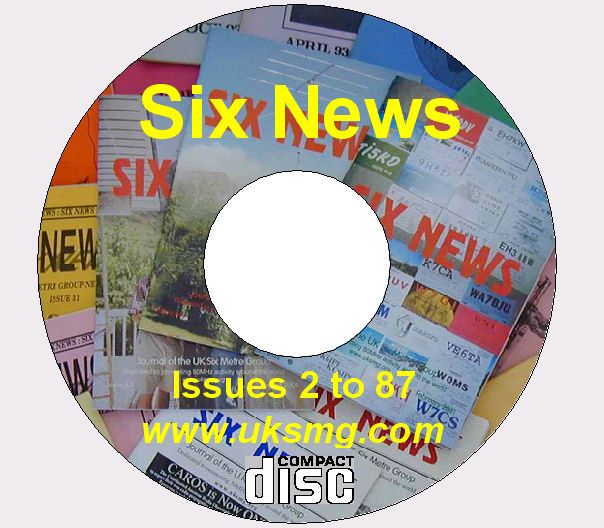
Thanks to all of our authors since 1982!
50 Years of 50 MHz Part 6 - Ken Willis, G8VR |
||||
|
In late August 1939 you could sense the enormous tension throughout the country, as war with Germany was now seen to be inevitable. I can recall the sunny morning of August 31 st at 07.20 BST when with my 25 watt two-valve transmitter I had a CW contact with ZL2CI, followed by one with TF5M, both on 14 MHz. I went on the air again later that day, at 21.45 BST, and worked G5YU, a local station. Here, from my log, is what he sent to me: “Say, OM. I have just heard that all G permits have been cancelled tonight. It was given out on the 9 pm news. Have you heard anything?” This was a blow, and morale sank to a low ebb a few days later when men in less-than-white coats came to collect all my equipment, which was taken away to be stored for the duration. In her next regular 56 Mc/s column in the old T & R Bulletin (now Radcom), Constance Hall, G8LY composed a ditty to the tune of “pack up your troubles” which ran: Hang up your headphones on the old shack wall And cuss, cuss, cuss, Hang up your headphones on the old shack wall But do not make a fuss. What's the use of listening, It hardly is worth while, so- Hang up your headphones on the old shack wall But smile, smile, smile. The years pass, and it is now January 1946. War indeed came and finally ended, and much water flowed under my personal bridge during the six years it lasted. My equipment was returned, looking, after all those years, strangely like stuff I throw on the local rubbish tip these days. Then came a cheering letter from the Engineer-in-Chief's Office, Radio Branch, GPO, London . Its essential paragraphs were: Dear Sir, Referring to your application for the issue of an amateur wireless transmitting licence you may be interested to learn that the military authorities have recently agreed to the use of frequencies in the band 28-29 Mc/sec and 58.5 - 60.0 Mc/sec. The power that may be used is limited to 25 watts in the band 58.5-60 Mc/sec but a power of 100 watts will be permitted in the band 28-29 Mc/sec. If you wish to avail yourself of the limited frequencies now available, arrangements will be made, on payment of the appropriate charge, for the issue to you of a licence to establish an amateur wireless station. I like the “Mc/sec” terminology! The charge mentioned was based on a formula related to power levels plus an annual amount. It worked out at one pound ten shillings a year for ten watts, two pounds ten shillings for 25 watts, and three pounds for over 25 watts - the price of a Sky Buddy every 30 months! But I dug deeply into my finances and signed up for the 100-watt ticket because I wanted the ten metre band. At the time my only equipment for frequencies above 30 MHz was my trusty TRF receiver. But Cycle 18 was about due to peak, and now I had my ticket to ‘Magic Band' territory back after the long shutdown.
Equipment Radio engineering progressed at a very fast rate during the long war, and those of us who were involved in it became associated with a whole range of equipment and techniques far superior to anything we had ever experienced as amateurs. Quite soon I was able to get my hands on a Hallicrafters S27 VHF general coverage receiver. By today's standards it was probably quite deaf, but to handle a receiver which so easily tuned the 50 MHz band as well as airborne VHF communications, and could reliably be set on a given frequency, was a revelation for me after suffering the squeaks which emerged from my three-valve TRF. I ‘listened to' the Battle of Britain on one of these receivers, and soon came to appreciate some of the differences which had existed between five and six metre operation in the UK and the USA. With receivers like the S27 readily available (at least up to the outbreak of war) American amateurs could more rapidly make the leap from early super-regen receivers and self-excited oscillators to more stable rigs similar to those being used on lower frequency bands. In 1947 the only British receiver with wide VHF coverage was the Eddystone 770R, which had been much used by the military for intercept work. Although superbly built (over-engineered might be a better term), this receiver was never popular as a piece of amateur station equipment. It was not very sensitive and somehow lacked the ‘feel' of the much simpler and cheaper Hallicrafters, but above all it was very much in the ‘boat-anchor' class as regards weight and portability - a real ‘hernia box'. I had one for a time and needed assistance to lift it on to the bench. Getting one upstairs was a nightmare. In the years immediately following the war UK amateurs using the five metre band quickly caught up as they built receive converters and crystal controlled transmitters to replace their more primitive pre-war equipment.
Antennas
Horizontal antennas have always posed a problem for mobile operators. For the old five metre band, a quarter-wave whip had almost always been used because it was convenient and unobtrusive. But it is by no means an efficient antenna for mobile use at these frequencies. Apart from the effects of cross-polarisation loss when working a base station, ignition noise in a car tends to be vertically polarised. One British amateur addressed the problem by mounting a full-sized three-element yagi on his car (see picture) and it was stated as being a fully mobile installation. It would have been a bit large for my 1929 Austin Seven, however!
Frank Stites, W1MUX took another approach. He set out to develop a compact horizontally-polarised mobile antenna with a circular radiation pattern. He decided that it must tune broadly, be easy to feed and work well when close to the metal body of a vehicle. He soon concluded that only something with a doughnut configuration would suffice. The outcome of much experiment was the Halo, of which Frank was the inventor, and the first ever model is pictured mounted on his car.
So the first halo was built for 50 MHz. When he first took it on the road he had to suffer comments such as: “Is it a shower bath?” or: “That's a funny place for a basket ball hoop!” Since Frank developed the halo while on the staff of the Naval Research Laboratory in Washington DC, the patents were assigned to that agency. I have known Frank for some years and have visited his home in Vermont and seen not only his 50 MHz station but an aeroplane which he built and flew himself.
I haven't previously mentioned five and six metre activity from ‘down under', but there are and always have been VKs just as fascinated by the ‘Magic Band' as we are in the UK. During 1947 there were some outstanding 50 MHz sporadic-E contacts across the continent at distances up to 1000 miles, producing a number of inter-state ‘first' claims. These occurred during December and the following month - these of course being summer months in VK-land. It is recorded that, as with some previous openings, the period was marked by violent thunderstorms. Years later, at the peak of Cycle 21 there were some very big 50 MHz F2 signals from VK6 as well as openings between Europe and the VK 3, 4, 5 and 8 call areas. At the time I noticed that signals from VK6 stations on the NW tip of the Australian continent were much more consistent than those from the Perth area, much further south. There were occasions when Steve, VK6PA was a lone VK calling CQ at S7-8 for an hour or more with virtually no takers, having worked everyone in earshot on the band at the time. I suspect that experienced six metre operator Graham, VK6RO also knew that this area would be a good spot for 50 MHz DX. I recently unearthed a report of his activities in September 1981, when he drove the 1200 miles from his QTH near Perth to the NW tip of Australia with the intention of stirring up some 50 MHz JA activity by operating from his car with a quarter wave whip antenna. At the time the VK band was 52-54 MHz. From several different sites during a 12-day expedition, he worked a total of 434 JAs: 233 of them on SSB, 47 on CW, 89 on AM and 65 on FM, some while using just one watt. He found that while the MUF would stay below 43-45 MHz during the day it would rise rapidly at sunset and every night a very strong FM broadcast station appeared on 56.6 MHz, apparently from China. At the time VK6RO commented “You may have heard a JA pile-up on SSB (not yet at G8VR, Graham!) , but you haven't heard anything until you hear one on AM”. From October 1979 to September 1981, VK6RO had no fewer than 754 mobile contacts with JA on 52 MHz, worked KG6DX and HL2JD and heard H44, P29 and ZS2. Goodness knows what he would have worked if he'd had one of Frank's halos. And think of writing out all those QSL cards!
Proof positive Here's a snippet from correspondence between two of the old-time ‘Six Metre Greats'. Ed Tilton W1HDQ, whose “The World Above 50 MHz” columns graced the QST journal for many years, was of course the USA station involved in the first 50 MHz transatlantic contacts (see Six News Issues 67 and 74). I have a letter that he wrote to Ken Ellis G5KW in January 1989, shortly after he had retired from his Connecticut home to one in Florida. He suggests that Ken should “Look for Arnie Bles, VK2AVA. He is former PA0UM who, with his friend PA0UN, made the first two-way six metre QSOs with me in 1947. I helped him get special limited authorisation for two-way 50 MHz work back then”. So now we have further confirmation from the great man himself. While the W1HDQ - G6DH QSO was the first USA-UK 50 MHz contact, the first transatlantic contact on Six was between PA0UN and W1HDQ on October 28 th 1947. G6DH didn't make it until November 5 th , and G5BY missed it by a whisker.
Finale Performance and manufacturing details for the W1MUX halo for six metres are fully covered in an article in QST for October 1947, and I would gladly send photocopies to anyone needing them if requested via e-mail at G8vr @aol.com or QTHR. The halo apparently out-performs a whip antenna by a considerable margin, and with F2 on the decline, mobile operation might blossom. It's a heavy antenna though!
UKSMG Six News issue 75, November 2002 |
the early history of 6m
six in fifty-seven
down memory lane
6m history
historical 6m
rigs
6m history by G6DH
50yrs of 50megs
pt1
50yrs of 50megs pt2
50yrs of 50megs pt3
50yrs of 50megs pt4
50yrs of 50megs pt5
